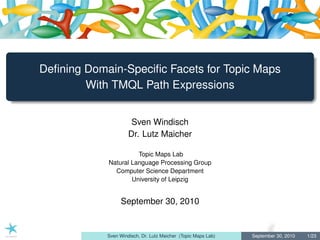Defining Domain-Specific Facets for Topic Maps With TMQL Path Expressions
- 1. De’¼üning Domain-Speci’¼üc Facets for Topic Maps With TMQL Path Expressions Sven Windisch Dr. Lutz Maicher Topic Maps Lab Natural Language Processing Group Computer Science Department University of Leipzig September 30, 2010 Sven Windisch, Dr. Lutz Maicher (Topic Maps Lab) September 30, 2010 1/23
- 2. Agenda Introduction to Facets in Topic Maps De’¼üning Domain-Speci’¼üc Facets With TMQL A Short Example Conclusions and Outlook Sven Windisch, Dr. Lutz Maicher (Topic Maps Lab) September 30, 2010 2/23
- 3. Overview Introduction to Facets in Topic Maps De’¼üning Domain-Speci’¼üc Facets With TMQL A Short Example Conclusions and Outlook Sven Windisch, Dr. Lutz Maicher (Topic Maps Lab) September 30, 2010 3/23
- 4. De’¼ünition of facets Facets are . . . . . . clearly de’¼üned, mutually exclusive, and collectively exhaustive aspects, properties or characteristics of a speci’¼üc subject. Example Some person has a name, a date of birth and a birthplace. These three characteristics are mutually exclusive and collectively exhaustive. They are facets of this person. Sven Windisch, Dr. Lutz Maicher (Topic Maps Lab) September 30, 2010 4/23
- 5. Mathematical De’¼ünition Any facet can be described as a triple, consisting of the parent identi’¼üer id(t) (i. e. whose Topics facet is this) the name of the facet n (e. g. Department, Format, Binding) the value of the facet v (e. g. Paperback, Hardcover ) f = (id(t), n, v) Sven Windisch, Dr. Lutz Maicher (Topic Maps Lab) September 30, 2010 5/23
- 6. Famous facet examples Yelp lists lots of different burgers in San Francisco. The facets help you with choosing the one place that ’¼üts your need best. Sven Windisch, Dr. Lutz Maicher (Topic Maps Lab) September 30, 2010 6/23
- 8. Facettable Elements of a Topic Names Names are very useful, but need careful spellchecking. Special Name types (e.g. Forename, Surname) provide a more concise classi’¼ücation. Occurrences Occurences with short values are ’¼üne for faceting. Again, careful spellchecking is necessary. Sven Windisch, Dr. Lutz Maicher (Topic Maps Lab) September 30, 2010 8/23
- 9. Facettable Elements of a Topic Roles A Topic plays a speci’¼üc Role, or not. Roles can therefore be used as ’¼éag-like facets. Topic Types Types of Topics are useful for distinguishing different kinds of search results. Sven Windisch, Dr. Lutz Maicher (Topic Maps Lab) September 30, 2010 9/23
- 10. Sven Windisch, Dr. Lutz Maicher (Topic Maps Lab) September 30, 2010 10/23
- 11. DonŌĆÖt they come automagically? Automatic generation of generic facets is possible (Ueberall et al. 2008). But: Information needs of users are highly domain speci’¼üc, while generic facets are not. Domain speci’¼üc facets must cover more than the the Topics characteristics. Sven Windisch, Dr. Lutz Maicher (Topic Maps Lab) September 30, 2010 11/23
- 12. Overview Introduction to Facets in Topic Maps De’¼üning Domain-Speci’¼üc Facets With TMQL A Short Example Conclusions and Outlook Sven Windisch, Dr. Lutz Maicher (Topic Maps Lab) September 30, 2010 12/23
- 13. Why TMQL? TMQL makes navigating through a Topic Map very easy But: Full TMQL is much too powerful for our requirements. The path expressions can do the whole job. De’¼ünition A path expression represents a sequence of navigation steps through the abstract bidirectional graph of a Topic Map. Starting from given values (atoms or items in a Topic Map), navigation steps along de’¼üned axes within the context map compute new values. Sven Windisch, Dr. Lutz Maicher (Topic Maps Lab) September 30, 2010 13/23
- 14. How to De’¼üne a Facet Any facet de’¼ünition resembles a simple path expression with the following limitations The starting element must be a Topic that serves as Topic type for other Topics. The possible result values are restricted to strings, because the names and values of facets must be human readable. The given Topic type identi’¼üer is replaced with the respective identi’¼üer of one of the instances. The TMQL expression is then executed and the result is stored as the facets value. Sven Windisch, Dr. Lutz Maicher (Topic Maps Lab) September 30, 2010 14/23
- 15. Overview Introduction to Facets in Topic Maps De’¼üning Domain-Speci’¼üc Facets With TMQL A Short Example Conclusions and Outlook Sven Windisch, Dr. Lutz Maicher (Topic Maps Lab) September 30, 2010 15/23
- 16. Example Topic Map Mission: Create an of’¼üce-location-facet for every person. Sven Windisch, Dr. Lutz Maicher (Topic Maps Lab) September 30, 2010 16/23
- 17. Navigating the Topic Map http://psi.example.com/person >> traverse http://psi.example.com/mailing-address >> traverse http://psi.example.com/container-containee-address >> characteristics tm:name Sven Windisch, Dr. Lutz Maicher (Topic Maps Lab) September 30, 2010 17/23
- 18. Navigating the Topic Map http://psi.example.com/person >> traverse http://psi.example.com/mailing-address >> traverse http://psi.example.com/container-containee-address >> characteristics tm:name Sven Windisch, Dr. Lutz Maicher (Topic Maps Lab) September 30, 2010 18/23
- 19. Navigating the Topic Map http://psi.example.com/person >> traverse http://psi.example.com/mailing-address >> traverse http://psi.example.com/container-containee-address >> characteristics tm:name Sven Windisch, Dr. Lutz Maicher (Topic Maps Lab) September 30, 2010 19/23
- 20. Navigating the Topic Map http://psi.example.com/person >> traverse http://psi.example.com/mailing-address >> traverse http://psi.example.com/container-containee-address >> characteristics tm:name Sven Windisch, Dr. Lutz Maicher (Topic Maps Lab) September 30, 2010 20/23
- 21. From TMQL to Facets in Three Simple Steps http://psi.example.com/person >> traverse http://psi.example.com/mailing-address >> traverse http://psi.example.com/container-containee-address >> characteristics tm:name http://psi.example.com/person is replaced by http://psi.example.com/Sven_Windisch The given query is executed, the result is Leipzig A new facet is created: (http://psi.example.com/Sven_Windisch, Of’¼üce Location, Leipzig) Sven Windisch, Dr. Lutz Maicher (Topic Maps Lab) September 30, 2010 21/23
- 22. Overview Introduction to Facets in Topic Maps De’¼üning Domain-Speci’¼üc Facets With TMQL A Short Example Conclusions and Outlook Sven Windisch, Dr. Lutz Maicher (Topic Maps Lab) September 30, 2010 22/23
- 23. Conclusions Domain-speci’¼üc facets are useful wherever facets must link deeper. TMQL does a wonderful job for de’¼üning domain-speci’¼üc facets. De’¼üning domain-speci’¼üc facets is easy. The used Topic Map must be well modeled and spellchecked. Outlook Release: Maiana prototype in October, complete search engine at the end of 2010 Sven Windisch, Dr. Lutz Maicher (Topic Maps Lab) September 30, 2010 23/23






















